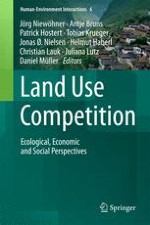This book contributes to broadening the interdisciplinary knowledge basis for the description, analysis and assessment of land use practices. It presents conceptual advances grounded in empirical case studies on four main themes: distal drivers, competing demands on different scales, changing food regimes and land-water competition.
Competition over land ownership and use is one of the key contexts in which the effects of global change on social-ecological systems unfold. As such, understanding these rapidly changing dynamics is one of the most pressing challenges of global change research in the 21st century. This book contributes to a deeper understanding of the manifold interactions between land systems, the economics of resource production, distribution and use, as well as the logics of local livelihoods and cultural contexts. It addresses a broad readership in the geosciences, land and environmental sciences, offering them an essential reference guide to land use competition.
